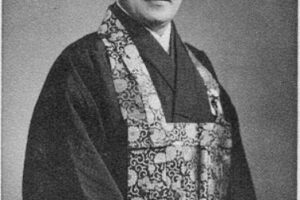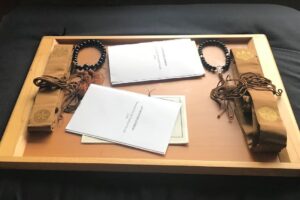Part 2

The great teachings of Buddhism fall into two main categories: description of reality and prescription for practice. In the last installment I reviewed the most familiar of Buddhist prescriptions, the Grave Precepts, specifically the first five given to Soto Zen Initiates in the Precepts ceremony (Jukai). In what follows I will comment briefly on the latter five of the Ten Grave Precepts, those received by candidates for lay ordination in the Discipleship ceremony (Zaike Tokudo). First, an excerpt from my concluding talk at the Atlantic Zen Center in Halifax last year, where we dedicated a week-long retreat and a series of public talks to the Precepts.
PRECEPTS AS PROCESS — Concluding Statement
We have spoken of the Precepts in the sense of taking action within the community, the communal aspect of practicing them, and lastly as a route to freedom—the spiritual aspect underlying the meaning of the Precepts. But the Precepts are not the most central action we take—zazen is. As Dogen Zenji reminds us, “What Precept is not fulfilled, sitting in zazen?” Matsuoka-roshi would often say, “This is the most you can do,” indicating zazen.
A precept is not an inert idea about reality, but more like a belief that we hold to be true.
zenkai taiun michael elliston, roshi
Precepts—the sixteen that Dogen Zenji articulated for his followers, and those we receive today—are not simply a set of rules that exist in a void. We all carry some form of personal precepts with us, whether conscious or unconscious. A precept is not an inert idea about reality, but more like a belief that we hold to be true. Each precept follows from a belief about the conditions of our existence, and is expressed as a prescription for behavior in the context of that belief.
For example, the Precepts read as prohibitions against killing, stealing, et cetera. They are based on an idea, or belief, about what it means to kill, or to steal. One’s belief, or personal precept, about killing may be something like “survival of the fittest”—it’s either me or you, and I am going to make sure, push comes to shove, that it is you, and not me. Or in terms of stealing, “there’s not enough to go around, it’s a win-lose situation, I’m going to make sure that I get mine.” These views are often translated into public precepts, in the form of agreed-upon, implicit if not explicit, societal mores, conventional wisdom, common sense, as well as hidden agendas.
We can see the relative or literal interpretation of the Precepts as a prescription for practice, guidelines for living with others and with ourselves. But they can be thought of as another kind of prescription, that of medicine—for what ails us, and for the afflictions of society. In this context, the Precepts follow on all of Buddhism’s teachings as medicine for the suffering of existence. Buddha is often referred to as a doctor, or the first psychologist, in this regard. He diagnosed an illness, made a prognosis, prescribed medicine and a course of therapy, and then treated his patients with compassion. It is of great importance that he included himself in the diagnosis.
The Precepts as medicine are a form of naturopathic treatment, like a vaccination. Something is out of balance in the system, and the patient is given a dose of the same disease, in order that the body-mind may react in a sufficiently drastic fashion as to develop antibodies capable of overcoming the virus. The virus in this case is the set of personal and societal precepts that are infecting us in ways that may be entirely unconscious. The Precepts of Zen cause an inflammation, a reaction that brings the irritations to the surface, so that the symptoms manifest in our awareness. As we recall and observe the Precepts in daily life (primarily through violating them), the personal precepts that underlie our behavior become more and more apparent. As we become aware of the infecting precepts that are affecting our health, it becomes possible to overcome them.
After receiving the Precepts, there comes a time when it is necessary to put them aside: when we are doing zazen. They are, after all, everyday concerns, to the degree that we can think about and analyze them. When we set them aside in zazen, then we open the door to witnessing their manifestation in practice. These are the real or true Precepts. They come from our direct insight and cannot be captured in words. Master Dogen’s phrasing was based on his direct insight, and your understanding will be based upon yours. It may be that you would come to express them differently, based on your direct experience. This does not mean that everyone should simply make up their own set of precepts; one should instead penetrate the Precepts as received, like so many koans, to grasp their reality.
But the Precepts as given by Master Dogen were not as he received them in China. And it is true that each individual reinvents Zen, and so comes to a personal grasp of the Precepts that is unique to that individual. Again, this is not arbitrary or intellectual, but arises out of deep insight. It might be better to say that we rediscover the same truth that Buddha and the Ancestors discovered, or uncovered, and so our expression of it will naturally be somewhat different.
Thus, the Precepts become a living process, arising out of the dynamic experience of living Zen, as sometimes expressed: “I take up the way of not killing”; “I take up the way of doing no harm.” We may not know exactly what it means to “Do no harm,” but that fact does not prevent us from taking up the way of doing no harm. Then, as we proceed through life, we are witness to the process of vowing to follow the Precepts, seeing from time to time that we have once again violated a Precept in some way that we did not grasp, and re-take the same Precept yet again.
This is a process of self-correcting, like course correction in flying an airplane, and eventually becomes second-nature. In recognizing that we are, or have been, violating a Precept without knowing it, we automatically correct, without giving it a second thought. Finally, it is hoped, our behavior becomes free of such violations of any intentional sort, and thus has no significant karmic consequence.
It is important in this regard that we do not develop an unconscious precept that we vow to avoid karmic consequence. This would be self-defeating. And probably self-fulfilling in the negative sense, that it would then be inevitable that our actions would have karmic consequences, precisely because we wish to avoid them.
Now, briefly, the last five of the ten Grave Precepts of Buddhas and Bodhisattvas (why do you suppose they are called “grave”?):
See only your own faults — Do not discuss the faults of others is probably the most easily and regularly violated, as gossip is seductive. We even enjoy hearing others, including fictional characters—not even real people—dishing and dissing in movies and television shows. Recall the comment of Huineng, who claimed “double vision”—that he saw clearly his own faults, and did not see the faults of others. What, then, did he see, exactly?
Know self and other as one — Do not praise yourself at others’ expense is similar to the above, but implies an internal dialog, rather than overt discussion. We can praise ourselves, to ourselves. No one need ever know. But we can also practice “secret virtue,” which no one else knows about, either. This latter is the action of the “true self” of Zen.
Share generously — Do not spare the Dharma assets is dana, in all forms. True generosity is natural and easy when one overcomes the tyranny of the little self. When it becomes indisputably clear that we are the recipient of the compassion, the generosity, of the Universe, by virtue of sheer existence, we have plenty of compassion, generosity, to share with others.
Actualize harmony — Do not indulge in anger reminds us that indulging is not the same as feeling. Buddhism does not teach that we should avoid feeling anger, or any other emotion—that would be escapism. Indulging is another story; it is self-indulgent. All emotions come with the territory, “born of body mouth and mind.” Get used to it.
Know intimacy with all things — Do not defame the Three Treasures is not as simple as it may seem. I may have inadvertently defamed the buddha, dharma, or sangha in the commentary above. When we represent the teachings of Buddhism, we are a bit in danger of the fall from grace that we witness in those religionists who claim to speak for God. It is better not to say anything at all. “Saying” here is not just of the mouth, but also of body and mind. Intimacy is “without defilement,” “dropping off without relying on anything,” according to Master Dogen.
Next time we will move on to another subject. If you would like to request a comment on some area of Zen Buddhism that you find confusing, or merely interesting, please send a note.
Gassho,
Hojo









